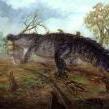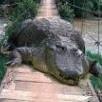Search the Community
Showing results for tags 'desert'.
-
^All Art is done by Lapis Lazuli and Dossier is edited by Mihael Common Name :Majungasaurus Species : Majungasaurus absconditus Time : Late Cretaceous Diet : Carnivorous Temperament :Opportunistic WILD: Majungasaurus absconditus is quite the interesting theropod. While most of the creatures of the ark look different to their real life counterparts, majungasaurus seems to have evolved to fit into a new niche in the arks ecosystem. It seems to have adapted many traits from modern day chameleons including the ability to change their skin color to camouflage into their surroundings. Many survivors often talk about how they feel like there's something always watching them just from the treeline out of sight and from my studies I believe that majungasaurus may be the culprit. They seem to have a higher intelligence than most creatures on the ark and are very curious by nature. Domesticated: A tamed majungasaurus however is a scientist's best friend. These creatures can be used to sneak up on and study even the most dangerous of animals and can even help find certain desired traits in wild creatures. And for those who would rather venture out on their own, some survivors have figured out how to modify their armor with the shedded scales of majungasaurus to give them limited camouflage. Taming: To tame a majungasaurus you must gain its trust by crafting structures and other trinkets to appease its curiosity. The higher quality item the less taming effectiveness is lost. Taming 2: To tame a majungasaurus you must gain its trust by feeding into its cannibalistic tendencies. You must kill and bring other majungasaurus to the target majunga Stat Reading: While camouflaged on a majunga you are able to sneak up on unsuspecting creatures. If you're able to get close enough your majunga will be able to act like a primitive HLNA from the genesis maps and read out the base stats of said creature. Camouflage Armor: As the majunga sheds its skin, survivors will be able to gather leftover scales and apply it to their armor to gain the majungas ability to camouflage. However unlike majunga survivors will only be able to camouflage while standing completely still. Combat: The majunga isn't really much of a fighter so it only has a basic bite attack that does around the same damage as a carno. Size: The Majunga would be around the size of Megalosaurus ingame which would allow it to be a new caving creature since we haven't gotten anything capable of caving in a long time. Suggestions from Replies: Getting a buff when eating another Majunga Eat other tamed Majungas when it gets low on hunger Main Attack does bonus damage if used while invisible (brings majunga out of invisibility)
- 160 replies
-
- 4
-

-

-
- camoflauge
- stealth
-
(and 7 more)
Tagged with:
-
Common name: Eocarcharia Species name: Eocarcharia dinops Time: Early Cretaceous Diet: Carnivore Temperament: Aggressive Wild: It's unknown if Eocarcharia hunted alone or in packs. Judging by its size (6-8m length) and fact that he is a Carcharodontosauridae there is a possbility they hunted in packs. Similar to Allosauruses, the Eocarcharias could wander in group of 3 members hunting small sauropods and hadrosaurs. Eocarcharias' fossils were found on Sahara, so they'd live on deserted areas of the map(s). Their bites would apply bleeding to their preys. Encyclopedia says Sarcosuchus might have been his potential enemy, so that could hint something? Bonus damage against crocodiles or something lol (no) Taming: Honestly, I am not sure. Most of lately added creatures have their own unique taming method. Maybe let's stay with knocking them out? Especially if they hunted in packs. Cannot think of something better at the moment uhh unless riding on them like on Equus (good luck) Domesticated: I swear I am trying to figure something out so it does not look like smaller Allosaurus copy...... Let's try to make them more mobile and fierce I wanna make them pack hunters as well but with small buffs so they are actually useful haha Abilities (While standing): LMB - Bite. RMB - Mega-Bite: The longer you hold button the more damage it does/the longer bleeding lasts. Applies bleeding. C - Roar: Would buff Damage of all Eocarcharias in pack. (Self included) (To do big damage) Abilities (While running): RMB - Lunge. Would perform a dash towards target enemy and apply the Mega-Bite. Maybe additionally slowing the target? I chose Lunge because they COULD NOT jump. C - Roar: Would buff Speed of all Eocarcharias in pack. (Self included) (To chase down the enemy) Eocarcharia could also increase it's running speed overtime and drift like Andrewsarchus. Army of Eocarcharias racing for kills! Additionally reduced weight for meat and hide (so they can hunt and hunt) (It's really hard to create a new mechanic for me because it's either already used or too complicated to program smh) It's one of my favorite less known dinosaurs. I'd love to see it getting some love from people. We do not have too much information on this dinosaur, but I managed to find something on various wikis. Also the name sounds cool B) I had fun making this one - my first submission! Enjoy ^^
-

Macroeuphractus - The Giant Armadillo
Boomslang81 posted a suggestion in Creature submission archive
Macroeuphractus - The Giant Armadillo Wild Seeing a Giant Armadillo was not the first thing I thought I would see on this Ark, but lo and behold, Macroeuphractus. This courageous hypercarnivore not only sees through the Yutyrannus' fear roar but seems to become more excited to fight. These armadillo's love to ball up but this can become a hindrance as they do become tired after a while. Tamed Even though they are hunted for their bulletproof hides, many tribes attempt to tame the Macroeupractus. With its fast speed and love for punch above its weight class, Macroeupractus is often used to herd sauropods and other large creatures. Abilities Fear Resistance Immune to Yuty Fear Roar Immune to Rhygo Taunt Slow Resistance Cannot be slowed by other creature abilities Bullet Sponge Backside takes 80% less damage Head takes 50% less damage Meteor Rush The longer it runs the faster it goes (Only in ball form) Courageous Does more damage to creatures with higher drag weight Attacks M1 - Bite M2 - Ball Up C - Speed up Like Andrewsarchus X - Sniff Locates creatures with higher drag weight -
This dinosaur is one of the most bird looking of them all and ARK needs more feather companions. Abilities I feel this bird should be like a parasaur but it rides on your Shoulder. So it should have the Threat detection ability. Taming Like most birds I feel confuciusornis sanctus should like Shiny things. Like metals,black pearls,crystal, etc So you will give it the things above and you will Keep doing this in till it gives you its egg but not all will sometimes they will give you resources or broken Equipment. thank you for reading sorry for not having a dossier.
-
Greetings Survivors! For this submission, the small, but dangerous Psittacosaurus vexoplectris make it's grand return to the submission forums to prove that you don't have to be a giant brute to save a life! DOSSIER TRANSCRIP: Common name: Psittacosaurus Species: Psittacosaurus vexoplectris Time: Early Cretaceous Diet: Herbivore Temperament: Defensive Wild: "Going off of its small size, You would expect that Psittacosaurus vexoplectris would be an easy meal for most smaller predators. But to my surprise, many of the carnivores in the desert avoid it. This is because this little critter has a few tricks up its sleeve." "Psittacosaurs possess very acute senses of smell, hearing and sight which allows them to evade predators very efficiently. In the event a threat gets too close, they can shoot off their toxic quills to deter them. While the toxin in these quills is not deadly, it does greatly irritate the skin and nervous system." Domesticated: "A tamed Psittacosaurus can be the difference between life and death for a survivor. It is able to spot ambushing predators from afar and alert its owner of the nearby threat. I've also heard that these creatures can even sniff out rare resources from under the desert sand." IN-GAME INFO: In life, Psittacosaurus is a small, Early Cretaceous ceratopsian found in several parts of Asia such as China, Mongolia, Russia, and Thialand. The ARK version is a desert-dwelling cactus cruncher that can perch on your shoulder. In the wild, you will often find Psittacos gathered in groups of about 4-5 individuals. The highest level of the group will be the "scout" for the group, serving as look out for the others. Whenever there is a threat, the scout will let out a call to alert the rest of the herd and give them the chance to escape while the scout stands guard to deter the threat by shooting its toxic quills. When the quills make contact with skin, it causes smaller animals such as Raptors, Direwolves and Terror Birds to retreat in pain. TAMING: In order to tame a Psittacosaurus, you'll need two key components: -a shield -Cactus Sap. 1.) First, you want to find a herd of Psittacos and begin to slowly approach the Scout. (It'll have a Pack Leader Glow around it, so you'll know which one it is) 2.) Then, you want to bring up your shield as the Scout enters its "Defensive Position" (it gets on all fours and raises its tail up, there will be about a 2-3 second grace period before it shoots) 3.) After shooting its quills, the Psittaco will enter its "tired state". it'll have its head and tail lowered and will be visibly panting. when in this state, feed it the cactus sap. 4.) Repeat Steps 1-3 untill tamed. Enjoy your new buddy! ABILITIES: Once tamed, your Psittacosaurus has quite a few abilities in its arsenal. -Bite: Simple bite attack. Nothing more, nothing less -Quill Shot: When either on your shoulder or on the ground, you can enable "Quill Shot Targeting". This allows the Psittaco to fire its quills at potential threats in a specific range (can be altered with its targeting range.) -Vocal Mimicry: Since the quills don't do much to larger animals, the Psittacosaurus is able to mimic the aggro sound of nearby large predators such as Rexes and Yutyrannus to alert you. PASSIVE ABILITIES: -Rare Resource Gathering: If placed on the terrain, the Psittacosaurus has a small chance to randomly dig up rare resources such as Pearls from the sand. -Repellant Darts: Psittacosaurus will passively produce a substance simply called "Psittacosaurus Toxin" which can be used to create Repellant Darts, which are made by combining a Tranquilizer Dart and the Psittaco Toxin. The darts can be fired from a Longneck Rifle and used on most creatures. the larger the creature, the more required to force hostile creatures to retreat. -Repellant Darts do NOT work on the following creatures: -Giganotosaurus -Carcharodontosaurus -Titanosaur -Brontosaurus -Extinction Titans -Alpha Dinos -Bosses And there you have it! Thank you for your reading! If you like this idea, feel free to give it a vote. It would really make my day if you did! Dossier Template by metatrox Dinosaur Art by Me (DangerFloof) (If you want more info on the real world version, here's the Wikipedia article on Psittacosaurus: https://en.wikipedia.org/wiki/Psittacosaurus)
-
- psittacosaurus
- ceratopsian
- (and 8 more)


.thumb.jpg.9012f89059ee285128dfd536cf5b4b33.jpg)
